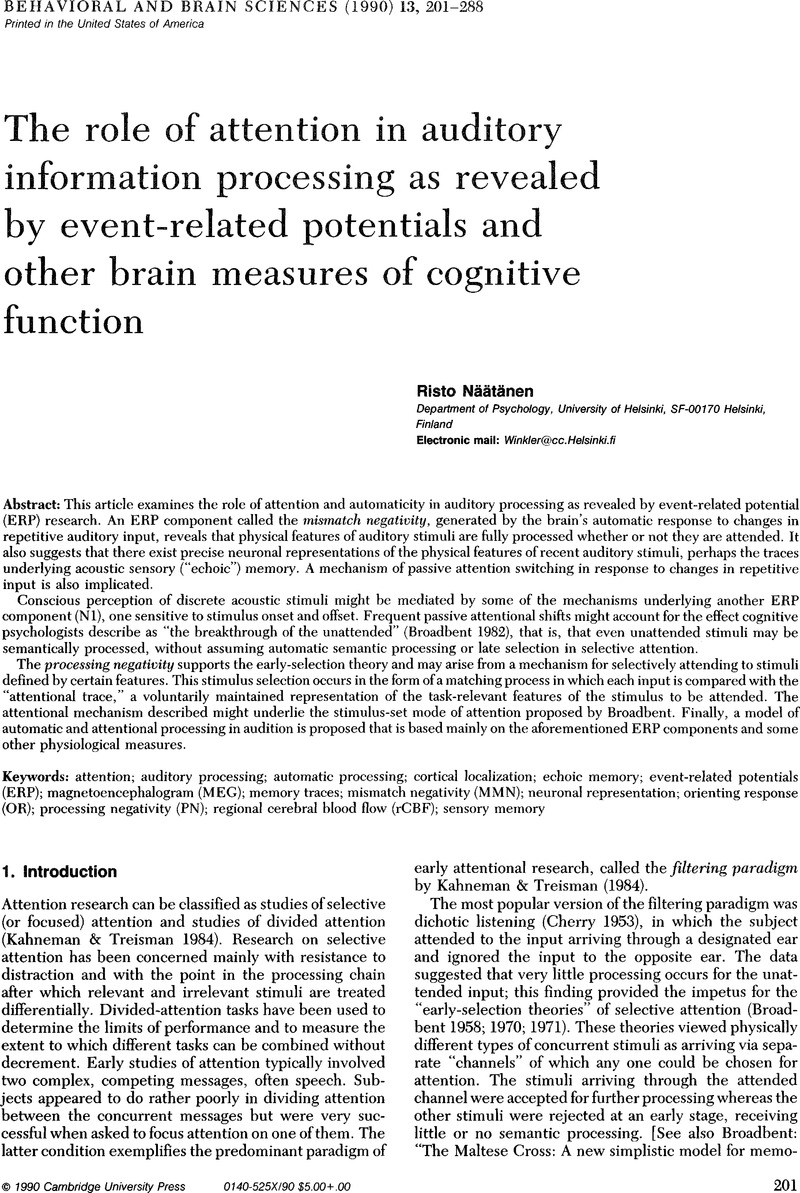Crossref Citations
This article has been cited by the following publications. This list is generated based on data provided by Crossref.
Paavilainen, Petri
Alho, Kimmo
Reinikainen, Kalevi
Sams, Mikko
and
Näätänen, Risto
1991.
Right hemisphere dominance of different mismatch negativities.
Electroencephalography and Clinical Neurophysiology,
Vol. 78,
Issue. 6,
p.
466.
GIESE‐DAVIS, JANINE E.
MILLER, GREGORY A.
and
KNIGHT, RAYMOND A.
1993.
Memory template comparison processes in anhedonia and dysthymia.
Psychophysiology,
Vol. 30,
Issue. 6,
p.
646.
TOWEY, JAMES P.
TENKE, CRAIG E.
BRUDER, GERARD E.
LEITE, PAUL
FRIEDMAN, DAVID
LIEBOWITZ, MICHAEL
and
HOLLANDER, ERIC
1994.
Brain event‐related potential correlates of overfocused attention in obsessive‐compulsive disorder.
Psychophysiology,
Vol. 31,
Issue. 6,
p.
535.
Näätänen, Risto
and
Alho, Kimmo
1995.
Mismatch negativity-a unique measure of sensory processing in audition.
International Journal of Neuroscience,
Vol. 80,
Issue. 1-4,
p.
317.
Eimer, M.
Nattkemper, D.
Schröger, E.
and
Prinz, W.
1996.
Attention.
Vol. 3,
Issue. ,
p.
155.
Luo, Yuejia
and
Wei, Jinghan
1997.
Mismatch negativity of ERP in cross-modal attention.
Science in China Series C: Life Sciences,
Vol. 40,
Issue. 6,
p.
604.
Tales, Andrea
Newton, Philip
Troscianko, Tom
and
Butler, Stuart
1999.
Mismatch negativity in the visual modality.
NeuroReport,
Vol. 10,
Issue. 16,
p.
3363.
Cheour, Marie
H.T. Leppänen, Paavo
and
Kraus, Nina
2000.
Mismatch negativity (MMN) as a tool for investigating auditory discrimination and sensory memory in infants and children.
Clinical Neurophysiology,
Vol. 111,
Issue. 1,
p.
4.
Tanaka, Masaaki
Okubo, Osami
Fuchigami, Tatsuo
and
Harada, Kensuke
2001.
A study of mismatch negativity in newborns.
Pediatrics International,
Vol. 43,
Issue. 3,
p.
281.
Wei, Jing-Han
Chan, Tin-Cheung
and
Luo, Yue-Jia
2002.
A modified oddball paradigm “cross-modal delayed response” and the research on mismatch negativity.
Brain Research Bulletin,
Vol. 57,
Issue. 2,
p.
221.
Horimoto, Reiko
Inagaki, Masumi
Yano, Takemi
Sata, Yoshimi
and
Kaga, Makiko
2002.
Mismatch negativity of the color modality during a selective attention task to auditory stimuli in children with mental retardation.
Brain and Development,
Vol. 24,
Issue. 7,
p.
703.
Pazo-Alvarez, P.
Cadaveira, F.
and
Amenedo, E.
2003.
MMN in the visual modality: a review.
Biological Psychology,
Vol. 63,
Issue. 3,
p.
199.
Mao, Wei
Wang, Yuping
Shi, Lixia
and
Wang, Dequan
2004.
Event-Related Potentials Elicited by Visual Stimulus-Duration Discrimination Tasks.
Clinical EEG and Neuroscience,
Vol. 35,
Issue. 2,
p.
78.
Astikainen, Piia
Ruusuvirta, Timo
Wikgren, Jan
and
Korhonen, Tapani
2004.
The human brain processes visual changes that are not cued by attended auditory stimulation.
Neuroscience Letters,
Vol. 368,
Issue. 2,
p.
231.
Maekawa, Toshihiko
Goto, Yoshinobu
Kinukawa, Naoko
Taniwaki, Takayuki
Kanba, Shigenobu
and
Tobimatsu, Shozo
2005.
Functional characterization of mismatch negativity to a visual stimulus.
Clinical Neurophysiology,
Vol. 116,
Issue. 10,
p.
2392.
Yucel, Gunes
McCarthy, Gregory
and
Belger, Aysenil
2007.
fMRI reveals that involuntary visual deviance processing is resource limited.
NeuroImage,
Vol. 34,
Issue. 3,
p.
1245.
Sittiprapaporn, Wichian
and
Kwon, Jun Soo
2009.
Artificial Neural Networks – ICANN 2009.
Vol. 5768,
Issue. ,
p.
345.
Clifford, Alexandra
Holmes, Amanda
Davies, Ian R.L.
and
Franklin, Anna
2010.
Color categories affect pre-attentive color perception.
Biological Psychology,
Vol. 85,
Issue. 2,
p.
275.
Axmacher, Nikolai
Cohen, Michael X.
Fell, Juergen
Haupt, Sven
Dümpelmann, Matthias
Elger, Christian E.
Schlaepfer, Thomas E.
Lenartz, Doris
Sturm, Volker
and
Ranganath, Charan
2010.
Intracranial EEG Correlates of Expectancy and Memory Formation in the Human Hippocampus and Nucleus Accumbens.
Neuron,
Vol. 65,
Issue. 4,
p.
541.
Gerger, Gernot
Leder, Helmut
Faerber, Stella J.
and
Carbon, Claus-Christian
2011.
When the Others Matter.
Swiss Journal of Psychology,
Vol. 70,
Issue. 2,
p.
75.



